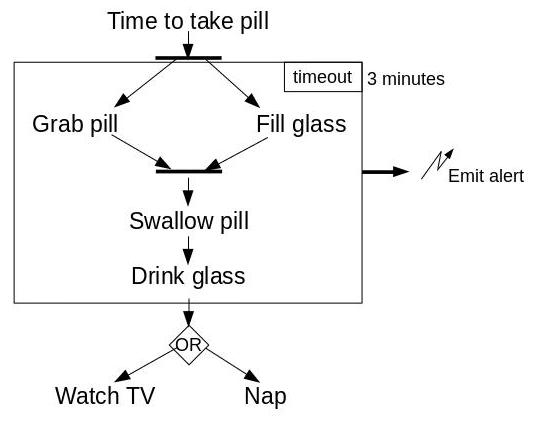Section: New Results
Synchronous Approach to Activity Recognition
Participants : Daniel Gaffé, Sabine Moisan, Annie Ressouche, Jean-Paul Rigault, Ines Sarray.
Activity Recognition aims at recognizing and understanding sequences of actions and movements of mobile objects (human beings, animals or artifacts), that follow the predefined model of an activity. We propose to describe activities as a series of actions, triggered and driven by environmental events.
This year we mainly refined the ADeL description language, the semantics of some of its instructions and their compilation into equation systems. We also improved the recognition engine and the synchronizer to better handle the synchronous/asynchronous transformation.
Work remains to be done to complete a full framework to generate generic recognition systems and automatic tools to interface with static and dynamic analysis tools, such as model checkers or performance monitors.
Activity Description Language
The ADeL language was designed to describe various activities, it provides two different (and equivalent) formats: graphical and textual. This year we started to describe use case examples in the medical domain: serious games and exercises for patients having cognitive problems, such as Alzheimer or autistic persons. This kind of games are used to test patients and to evaluate their behavior and interactions. These use cases lead us to improve the language and part of its semantics. An example of the graphical format describing a simple exercise activity is given in figure 23.
|
Work remains to be done to improve the usability of the language by our end-users.
Synchronizer
Using the synchronous paradigm makes time manipulation easy thanks to determinism and synchronous parallellism; moreover, tools exist to support formal verification. However, the sensor environment is asynchronous and it is thus necessary to transform asynchronous events given by sensors into synchronous logical instants. It is a difficult problem that does not have an exact and complete solution. We introduced a component called "synchronizer" between the environment sensors and the recognition engine. The synchronizer is responsible for filtering the sensor data, grouping them into logical instants, and sending these instants to the recognition engine.
We specified a generic algorithm, based on awaited events, i.e. the events which may trigger transitions to a next state. These events are provided by each automaton in each state. This algorithm is parametrized by heuristics to adapt to different situations. There are two main points of variation in the synchronizer where heuristics can be applied: when processing data coming from the sensors (to collect and combine raw data) and when building logical instants (to decide on the end of instants and to manage preemptions).
This year we finished to implement a first version of the synchronizer (for one single activity to recognize), we defined different heuristics, and we tested the synchronizer algorithm on some uses cases with these heuristics [11].


